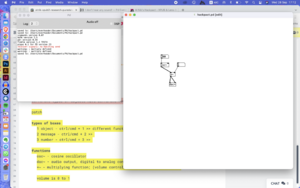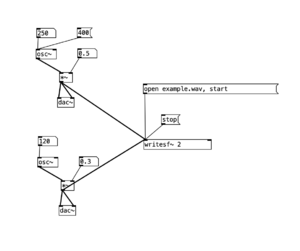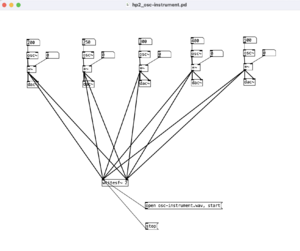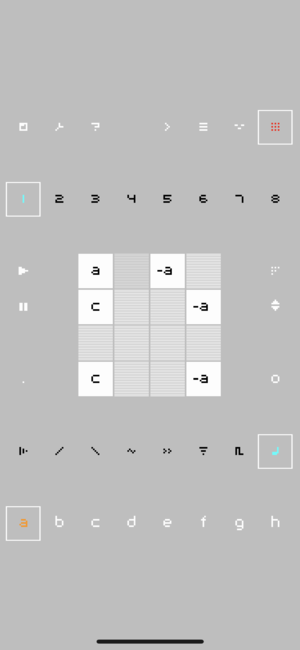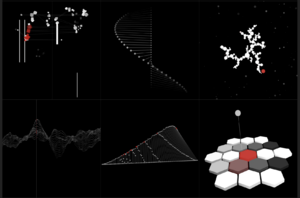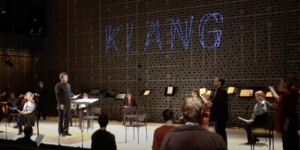Al Nik's Hackpact: Difference between revisions
No edit summary |
|||
| (44 intermediate revisions by the same user not shown) | |||
| Line 165: | Line 165: | ||
=<span style="color: white; font-family: Menlo; text-decoration:none; background-color: #cc00cc; padding-top: 0.1vw; padding-bottom: 0.1vw; padding-left: 0.1vw; padding-right: 0.2vw;"> research places </span> = | ==<span style="color: white; font-family: Menlo; text-decoration:none; background-color: #cc00cc; padding-top: 0.1vw; padding-bottom: 0.1vw; padding-left: 0.1vw; padding-right: 0.2vw;">_[inclusive instruments research] </span> == | ||
'''[about]''' instruments that are given to the participants during the jam shape the overall experience and play a big role. My sub-research questions here are: | |||
_how do instruments shape the sound jam? | |||
_what kind of instruments are most accessible for people who don't have musical training? | |||
_what instruments can I prepare/build in advance, to give a fair start to the jam participants? | |||
'''[instruments to try out]''' <br> | |||
=== voice === | |||
'''[concept]''' Voice is an instrument that every participant possesses. It can bring a lot of restraint in the collective sound-making process, thus also a lot of creativity. It is a way to put everyone at the same level, but of course, some participants could already have more experience with working with their voice. Nevertheless, that is not an issue - no matter what instruments we choose, people will always come from different backgrounds and levels of experience. | |||
=== acoustic music instruments === | |||
'''[research question]''' what musical instruments can be accessible for people without musical training? List of ideas and instruments to test out: | |||
_kalimba | |||
_harp | |||
_egg shaker | |||
=== pure data instrument === | |||
=== nanoloop === | |||
''// november 2022'' | |||
[[File:Nanoloop.png|thumb]] | |||
Nanoloop combines sequencer, synthesizer and sampler in one package. It provides all functions for creating electronic music from scratch. The iOS app builds on Nanoloop for the Gameboy, but features a new software synth and features not possible on the Gameboy. The touch screen makes it easy to navigate and quite accessible for beginners. <br> | |||
'''[process log]'''<br> | |||
_installed the app on my iPad | |||
_quickly checked [https://www.youtube.com/watch?v=MdlJuojjuUg a tutorial] how to get started | |||
_made first sample by trying out the menu elements | |||
{{Audio|mp3=https://pzwiki.wdka.nl/mw-mediadesign/images/3/3d/Nano-0.mp3|nanoloop snippet}} | |||
=== objects === | |||
==<span style="color: white; font-family: Menlo; text-decoration:none; background-color: #cc00cc; padding-top: 0.1vw; padding-bottom: 0.1vw; padding-left: 0.1vw; padding-right: 0.2vw;">_[remnants of future voices] </span> == | |||
'''''17-10-2022''''' | |||
<br> | |||
'''[about]''' Mitsa and I attend one of the workshops that are part of "In Search of Good Ancestors” series, facilitated by Jonathan Chaim Reus in collaboration with Angeliki Diakrousi. What we did was an exploration of ancestral cosmology through the figure of the clone in artificial voice technologies. We recorded our voices and created clones which could say anything (in English). In order to train the machine with my voice, I actually recorded some tongue-twisters in Bulgarian! It worked super well and then I made up a short conversation piece between a clone of my voice and my friend Mitsa’s voice. We talk sometime in the future - Mitsa clone is from the future, mine is from the past and we talk about how it was back then. Listen to my audio contribution here & learn more about the project here. <br> | |||
'''[contribution]'''<br> | |||
Conversation piece from the future past | |||
Mitsa's and Alex's clones are talking | |||
Mitsa's clone is in the future | |||
Alex's clone is in the past | |||
They are having a quick chat | |||
Somewhere and sometime in the future | |||
{{Audio|mp3=https://hub.xpub.nl/soupboat/~alnik/xpub2/hackpact/future-past/conversation-from-the-future-past.mp3}} | |||
<br> | |||
▶ [https://hub.xpub.nl/soupboat/~alnik/xpub2/hackpact/future-past/conversation-from-the-future-past.wav download here]<br> | |||
▶ [https://pad.xpub.nl/p/alnik-xpub2-workshops-remnants-of-future-voices pad with my annotations & work] <br> | |||
=<span style="color: white; font-family: Menlo; text-decoration:none; background-color: #0033ff; padding-top: 0.1vw; padding-bottom: 0.1vw; padding-left: 0.1vw; padding-right: 0.2vw;"> _research places </span> = | |||
====wiki==== | ====wiki==== | ||
▶ [[Al | ▶ [[Al's XPUB2 thesis]]<br> | ||
▶ [[Al's XPUB2 proposal draft]]<br> | |||
▶ [[Al's XPUB2 thesis outline]]<br> | |||
▶ [[Sound jams research]] <br> | ▶ [[Sound jams research]] <br> | ||
▶ [[Sound Jams: Handbook]] <br> | |||
====wip==== | ====wip==== | ||
| Line 182: | Line 240: | ||
▶ [https://pad.xpub.nl/p/alnik-xpub2-research-puredata pure data] <br> | ▶ [https://pad.xpub.nl/p/alnik-xpub2-research-puredata pure data] <br> | ||
▶ [https://pad.xpub.nl/p/alnik-xpub2-research-livecoding live coding] <br> | ▶ [https://pad.xpub.nl/p/alnik-xpub2-research-livecoding live coding] <br> | ||
▶ [https://pad.xpub.nl/p/alnik-xpub2-research-experimental-music experimental music] <br> | |||
▶ [https://pad.xpub.nl/p/alnik-xpub2-research-fluxus-group Fluxus group] <br> | |||
====references pads==== | |||
▶ [https://pad.xpub.nl/p/alnik-xpub2-references-notation notation] <br> | |||
▶ [https://pad.xpub.nl/p/alnik-xpub2-references-ocean-of-sound ocean of sound] <br> | |||
▶ [https://pad.xpub.nl/p/alnik-xpub2-references-nearness nearness] <br> | |||
▶ [https://pad.xpub.nl/p/alnik-xpub2-references-beneath-maiwar beneath maiwar] <br> | |||
▶ [https://pad.xpub.nl/p/alnik-xpub2-references-christian-marclay christian marclay] <br> | |||
▶ [https://pad.xpub.nl/p/alnik-xpub2-references-research-document artistic research document] <br> | |||
=<span style="color: white; font-family: Menlo; text-decoration:none; background-color: #0033ff; padding-top: 0.1vw; padding-bottom: 0.1vw; padding-left: 0.1vw; padding-right: 0.2vw;"> _updated timeline </span>= | |||
_1 // october-january // <s>research of existing methods for collective sound-making and publishing</s><br> | |||
_2 // october-january // <s>drafting, shaping, testing tools for collective sound-making and publishing</s><br> | |||
_3 // [wip] october-march // facilitating and documenting sound jams & creating prototyping publication modules out of them<br> | |||
_<s>m&ms</s> - jamming session - 11 participants, @PZI<br> | |||
_<s>what do books say?</s> - workshop - 12 participants, @leeszaal [[https://pad.xpub.nl/p/alnik-xpub2-soundjam-leeszaal documentation]]<br> | |||
_<s>transverse atlantis elective</s> - workshop - 18 participants, @wdka [[https://pad.xpub.nl/p/alnik-xpub2-soundjam-elective documentation]]<br> | |||
_<s>sound impro jam at re#sister</s> - jamming session - 3 participants, @worm [[http://wiki.alnik.me/index.php?title=Sound%20jams:%20resister%20at%20worm documentation]]<br> | |||
_[wip] reversed words - online call - tba @online <br> | |||
_4 // march-april // revision, reflection, revisiting instructions, feedback - writing thesis<br> | |||
_5 // april-may // prototyping the publication [with printable and digital elements]<br> | |||
_6 // april-may // deciding on what and how to present it at the grad show<br> | |||
_7 // may-june // making the publication<br> | |||
_8 // june-july // presenting the publication [grad show]<br> | |||
=<span style="color: white; font-family: Menlo; text-decoration:none; background-color: #0033ff; padding-top: 0.1vw; padding-bottom: 0.1vw; padding-left: 0.1vw; padding-right: 0.2vw;"> _references/bibliography </span>= | |||
''what informs the whole research''<br> | |||
[[File:Hackpact by Nagy.png|thumb]] | |||
====books==== | |||
''Abrams, D. and Hogg, M.A. (1988). Social Identifications. '' Routledge.<br> | |||
''adrienne maree brown, (2019). Pleasure Activism. The Politics of Feeling Good.'' Chico, Edinburgh. AK Press. [[https://pad.xpub.nl/p/alnik-xpub2-pleasure-activism annotated pad]]<br> | |||
''Cardew C. (ed.), (1969). Nature Study Notes.'' Scratch Orchestra, Experimental Music Catalogue.<br> | |||
''Emiel Heijnen and Bremmer, M. (2020). Wicked Arts Assignments Practising Creativity in Contemporary Arts Education. ''Amsterdam Valiz.<br> | |||
''Evens, A., (2005). Sound Ideas: Music, Machines & Experience.'' U of Minnesota Press [[https://pad.xpub.nl/p/alnik-xpub2-references-sound-ideas annotated pad]] <br> | |||
''Groot, M. (2019). The Amateur's Armour.'' [online] Available at: <https://underbelly.nu/wp-content/uploads/2015/04/The-Amateurs-Armour.pdf> [Accessed 11 October 2022].<br> | |||
''Hunter, M.A. (2008). Cultivating the art of safe space. Research in Drama Education: The Journal of Applied Theatre and Performance, 13(1), pp.5–21.'' doi:https://doi.org/10.1080/13569780701825195.<br> | |||
''Kreidler, J. (2013). loadbang. Programming Electronic Music in Pure Data.'' 2nd edition. Hofheim: Wolke Verlag. <br> | |||
''La Monte Young (1963). An anthology of chance operations.'' <br> | |||
''Oliveros, P., (2005). Deep Listening.'' New York. Deep Listening Publications. [[https://pad.xpub.nl/p/alnik-xpub2-references-deep-listening annotated pad]] <br> | |||
''Toop, D. (2018). Ocean of Sound.'' Serpent’s Tail. [[https://pad.xpub.nl/p/alnik-xpub2-references-ocean-of-sound annotated pad]]<br> | |||
''Vis, D. (2021). Research for people who (think they) would rather create.'' Netherlands: Onomatopee.<br> | |||
''Weiss, A., (2001). Experimental Sound & Radio.'' The MIT Press. <br> | |||
''Yōko Ono (1971). Grapefruit. New York: Simon And Schuster.'' <br> | |||
''Yuill, S. (). All Problems of Notation Will be Solved by the Masses: Free Open Form Performance, Free/Libre Open Source Software, and Distributive Practice.'' <br> | |||
<br> | |||
''Handbook Of Urban Exploration For Youths. (2022) Urbex.'' <br> | |||
====sound publications==== | |||
'''''Brown, A. R., (2022). Beneath Maiwar.'''''[online] Available at: <https://www.explodingart.com/arb/2022/06/28/beneath-maiwar/> [Accessed 30 September 2022]. [[https://pad.xpub.nl/p/alnik-xpub2-references-beneath-maiwar annotated pad]] <br> | |||
'''''Nagy, A., (2018). Hackpact / Sonification Studies.''''' [online] Available at: <https://stc.github.io/HackPact/> [Accessed 30 September 2022]. [[https://pad.xpub.nl/p/alnik-xpub2-references-hackpact-sonification annotated pad]] | |||
====scores & notations==== | |||
[[File:Screenshot of video by Cornelius Cardew.png|thumb]] | |||
[[File:Screenshot of notation by Cordelius Cardew.png|thumb]] | |||
'''''Cardew, C. (2014) The Great Learning, Paragraph 7 (workshop, live)''''' Helsinki, Finland [[https://pad.xpub.nl/p/alnik-xpub2-references-thegreatlearning annotated pad]] | |||
[https://pad.xpub.nl/p/alnik-xpub2-research-fluxus-group Fluxus group] | |||
Latest revision as of 16:39, 27 March 2023
_about
it's just a toy! - bruno
here are several research & experiments hackpacts to start with ⟿
_[audiozines]
// 27-09-2022
[format] playing with audiozines as focus on format rather than on a topic.
[wip pad] is here
[process log]
research - i became quite interested in zines as a format and since we're experimenting with audio a lot, the combo looks like a good starting point for me. Started with a small research. (more details in the pad)
timeline
_1970-1980s - audio cassettes
_1997+ - compact discs (becoming more hybrid, + image and video)
_2000s - web based; podzines (ipods; downloadable)
_2010s - becoming podcasts
main characteristics
_small scale content
_analog turned digital through tech development
_notion of limitation - in length, in size, in accessibility
_often come in series
_radical, anarchistic content (now)
_independent publishers (now)
_spoken words
_non-fiction content, but often connected to science fiction pieces (at least for a few decades)
_curated, conceptual content
_DIY culture
why interesting in audiozines?
_DYI and independent publishing notion
_limitations - in terms of length, accessibility, distribution - small scale contents
_conceptual (curated, but raw)
_connection to analog - audio cassette origins
_connection with print zines - can have its own printed zine edition as well
_[pure data intro]
// 28-09-2022
[format] experiment with focus on format (instead of topic). First baby steps in getting to know Pd.
[work] with Mitsa
[wip pad] is here
[process log]
research - for the experiment, i have researched a bit what pure data is and what tutorials we can use to start. As Mitsa and i are interested in creating sounds, music, edit audio with it, i proposed us to try the tutorials created by Australian artist and educator Andrew R. Brown.
He has published a series of 53 video tutorials for getting to use Pure Data for Real-time music and sound.
creating a simple oscillator with pure data - process log
1_ download pure data vanilla - here 2_ create a new patch 3_ create the following boxes: object box with osc~; object box with audio output (digital to analog converter); object for defining the volume - object box with multiplying function and number box to define the volume number; finally, a number box to adjust the osc frequency. 4_ connect them with sound on to hear the osc sound. 5_ add another one and play with frequencies. 6_ record the sound in pure data - by adding a message, start and stop. (listen to the third audio)
why interested in pure data?
as part of the master project research, we (Mitsa and Alex) are looking for various methods and tools to collect and edit sound and music. What we like about pure data is its visual interface and mapping style. It is also a way to build complex pieces and mix already existing audio with newly programmed sounds. It is a free software, independent; also new to us both.
building an instrument
after experimenting with recording the simple oscillator sounds and uploading them both here, the idea of building an instrument on the wiki arose. :) you can play the audio files above at the same time or play with different overlappings. now, imagine this with more sounds!
_[osc instrument]
// 30-09-2022
[about] for this experiment, i am using pure data to build a very simple instrument only by using oscillators, tuned in different frequencies. Not advancing with more tutorials, but building up on the first and simple one. Made additional research how to record audio and how to press "start" and "stop" of playing various objects in Pd.
[process log]
1_ create an oscillator 2_ replicate it 4 times 3_ set different frequency values to each osc 4_ record by playing different sequences and combinations 5_ up next: find out how to add start and stop buttons to play
[result] first try out :)
_[jam facilitation]
prep // 8-10-2022
jam // 10-10-2022
[about] facilitation jam experiment preparation and implementation at the next M&Ms session. For the preparation, we were looking for a read that can fit the idea of the reflection over some text through collective sound creation. For the implementation, we prepared two different scores the collective can follow while jamming.
[process log]
1_ brainstorming and brainwriting about ways to facilitate a jamming session 2_ re-assessing why we want to use the format of a jam 3_ selecting a jam facilitation for M&Ms 4_ writing down the programme of the whole session + what we want to get from it 5_ inviting the group to bring instruments (telling them in advance) 6_ going through different reads and discussing what we want to reflect on during the jam 7_ choosing the book; choosing extracts from it to read during the session; editing 8_ prepare the instruments for the session 9_ prepare the space
[result]
▶▶ documentation of the M&Ms jam
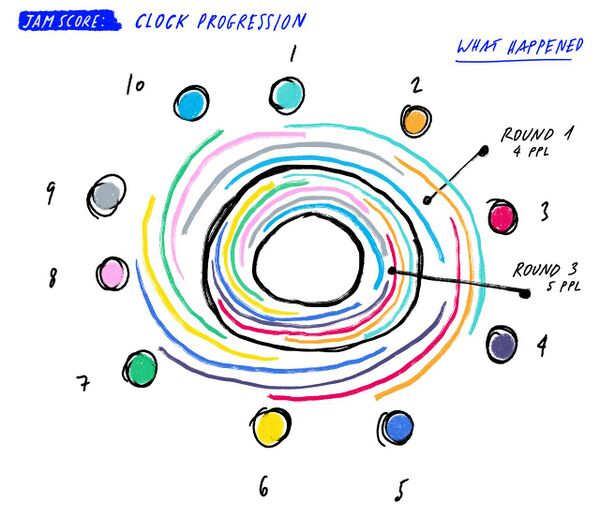
_[collective audiozine making]
17-10-2022
[about] Making a collective audiozine, by listening and responding to what books say. Ingredients: listen, choose, respond. For this experiment, we played with the specifics of the space - leeszaal; and tried out another way to create a collective sound publication.
[process log]
1_ Mitsa picked a book: The Rotters' Club by Johnatan Coe and read a paragraph of it. 2_ Alex listened to it and thought about what associations that brought. She picked another book: The Slap by Christos Tsiolkas. 3_ These two try outs were the start of our process: we invited each guest to listen to the recording of the previous contributor, reflect a bit and respond with another recording. The intention was to read parts of the books around the library, but at some point, someone responded by recording the sounds in the room. And the next one as well. And the next one as well. Until someone got back to reading the books. 4_ We recorded: the contributions with one Zoom N1; and then asked the contributors a few questions about their experience - recorded the reflections with another device.
[result] tba
_[inclusive instruments research]
[about] instruments that are given to the participants during the jam shape the overall experience and play a big role. My sub-research questions here are:
_how do instruments shape the sound jam? _what kind of instruments are most accessible for people who don't have musical training? _what instruments can I prepare/build in advance, to give a fair start to the jam participants?
[instruments to try out]
voice
[concept] Voice is an instrument that every participant possesses. It can bring a lot of restraint in the collective sound-making process, thus also a lot of creativity. It is a way to put everyone at the same level, but of course, some participants could already have more experience with working with their voice. Nevertheless, that is not an issue - no matter what instruments we choose, people will always come from different backgrounds and levels of experience.
acoustic music instruments
[research question] what musical instruments can be accessible for people without musical training? List of ideas and instruments to test out:
_kalimba _harp _egg shaker
pure data instrument
nanoloop
// november 2022
Nanoloop combines sequencer, synthesizer and sampler in one package. It provides all functions for creating electronic music from scratch. The iOS app builds on Nanoloop for the Gameboy, but features a new software synth and features not possible on the Gameboy. The touch screen makes it easy to navigate and quite accessible for beginners.
[process log]
_installed the app on my iPad _quickly checked a tutorial how to get started _made first sample by trying out the menu elements
objects
_[remnants of future voices]
17-10-2022
[about] Mitsa and I attend one of the workshops that are part of "In Search of Good Ancestors” series, facilitated by Jonathan Chaim Reus in collaboration with Angeliki Diakrousi. What we did was an exploration of ancestral cosmology through the figure of the clone in artificial voice technologies. We recorded our voices and created clones which could say anything (in English). In order to train the machine with my voice, I actually recorded some tongue-twisters in Bulgarian! It worked super well and then I made up a short conversation piece between a clone of my voice and my friend Mitsa’s voice. We talk sometime in the future - Mitsa clone is from the future, mine is from the past and we talk about how it was back then. Listen to my audio contribution here & learn more about the project here.
[contribution]
Conversation piece from the future past Mitsa's and Alex's clones are talking Mitsa's clone is in the future Alex's clone is in the past They are having a quick chat Somewhere and sometime in the future
▶ download here
▶ pad with my annotations & work
_research places
wiki
▶ Al's XPUB2 thesis
▶ Al's XPUB2 proposal draft
▶ Al's XPUB2 thesis outline
▶ Sound jams research
▶ Sound Jams: Handbook
wip
▶ the first draft pad [created during the Graduate Seminar on 29-09-2022]
▶ jams ideas
▶ references - collective pad with Mitsa
▶ tagging and mapping research elements
▶ wikimedia setup - creating a space for collaborative work; for documentation and presentation of the sound-based publications from the research // work in progress
research pads
▶ glossary
▶ audiozines
▶ pure data
▶ live coding
▶ experimental music
▶ Fluxus group
references pads
▶ notation
▶ ocean of sound
▶ nearness
▶ beneath maiwar
▶ christian marclay
▶ artistic research document
_updated timeline
_1 // october-january // research of existing methods for collective sound-making and publishing
_2 // october-january // drafting, shaping, testing tools for collective sound-making and publishing
_3 // [wip] october-march // facilitating and documenting sound jams & creating prototyping publication modules out of them
_m&ms- jamming session - 11 participants, @PZI
_what do books say?- workshop - 12 participants, @leeszaal [documentation]
_transverse atlantis elective- workshop - 18 participants, @wdka [documentation]
_sound impro jam at re#sister- jamming session - 3 participants, @worm [documentation]
_[wip] reversed words - online call - tba @online
_4 // march-april // revision, reflection, revisiting instructions, feedback - writing thesis
_5 // april-may // prototyping the publication [with printable and digital elements]
_6 // april-may // deciding on what and how to present it at the grad show
_7 // may-june // making the publication
_8 // june-july // presenting the publication [grad show]
_references/bibliography
what informs the whole research
books
Abrams, D. and Hogg, M.A. (1988). Social Identifications. Routledge.
adrienne maree brown, (2019). Pleasure Activism. The Politics of Feeling Good. Chico, Edinburgh. AK Press. [annotated pad]
Cardew C. (ed.), (1969). Nature Study Notes. Scratch Orchestra, Experimental Music Catalogue.
Emiel Heijnen and Bremmer, M. (2020). Wicked Arts Assignments Practising Creativity in Contemporary Arts Education. Amsterdam Valiz.
Evens, A., (2005). Sound Ideas: Music, Machines & Experience. U of Minnesota Press [annotated pad]
Groot, M. (2019). The Amateur's Armour. [online] Available at: <https://underbelly.nu/wp-content/uploads/2015/04/The-Amateurs-Armour.pdf> [Accessed 11 October 2022].
Hunter, M.A. (2008). Cultivating the art of safe space. Research in Drama Education: The Journal of Applied Theatre and Performance, 13(1), pp.5–21. doi:https://doi.org/10.1080/13569780701825195.
Kreidler, J. (2013). loadbang. Programming Electronic Music in Pure Data. 2nd edition. Hofheim: Wolke Verlag.
La Monte Young (1963). An anthology of chance operations.
Oliveros, P., (2005). Deep Listening. New York. Deep Listening Publications. [annotated pad]
Toop, D. (2018). Ocean of Sound. Serpent’s Tail. [annotated pad]
Vis, D. (2021). Research for people who (think they) would rather create. Netherlands: Onomatopee.
Weiss, A., (2001). Experimental Sound & Radio. The MIT Press.
Yōko Ono (1971). Grapefruit. New York: Simon And Schuster.
Yuill, S. (). All Problems of Notation Will be Solved by the Masses: Free Open Form Performance, Free/Libre Open Source Software, and Distributive Practice.
Handbook Of Urban Exploration For Youths. (2022) Urbex.
sound publications
Brown, A. R., (2022). Beneath Maiwar.[online] Available at: <https://www.explodingart.com/arb/2022/06/28/beneath-maiwar/> [Accessed 30 September 2022]. [annotated pad]
Nagy, A., (2018). Hackpact / Sonification Studies. [online] Available at: <https://stc.github.io/HackPact/> [Accessed 30 September 2022]. [annotated pad]
scores & notations
Cardew, C. (2014) The Great Learning, Paragraph 7 (workshop, live) Helsinki, Finland [annotated pad]

